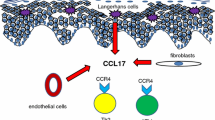Abstract
Leukocyte trafficking is critically regulated by chemokines and their receptors. The involvement of the skin in certain subsets of T-cell malignancies has been explained by the discovery of an interaction between the thymus and activation-regulated chemokine (TARC), which is abundant in the skin, and its receptor, CC chemokine receptor 4 (CCR4), which is expressed in the tumor cells. We describe a diffuse large B-cell lymphoma (DLBCL) that showed CCR4 expression with involvement of the skin. A 55-year-old man presented with a giant skin ulcer of the right axilla, and his disease was diagnosed as DLBCL. Further clinical examination revealed an ulcerated gastric lymphoma lesion. Immunohistochemical and real-time reverse transcriptase-polymerase chain reaction analyses showed that the tumor cells were positive for CCR4, andTARC was expressed at extremely high levels in the lymphoma-affected skin. These observations suggest that the interaction between CCR4 and TARC played a significant role in the involvement of the skin in this case, similar to what has been observed in certain subsets of T-cell malignancies. To the best of our knowledge, this report is the first of a CCR4-positive B-cell lymphoma. The present case provides new insights into the pathogenesis of skin involvement in B-cell lymphomas.
Similar content being viewed by others
References
Zlotnik A, Yoshie O. Chemokines: a new classification system and their role in immunity.Immunity. 2000;12:121–127.
Campbell JJ, Butcher EC. Chemokines in tissue-specific and microenvironment-specific lymphocyte homing.Curr Opin Immunol. 2000;12:336–341.
Bucher EC, Williams M, Youngman K, Rott L, Briskin M. Lymphocyte trafficking and regional immunity.Adv Immunol. 1999;72:209–253.
Müller A, Homey B, Soto H, et al. Involvement of chemokine receptors in breast cancer metastasis.Nature. 2001;410:50–56.
Kunkel EJ, Boisvert J, Murphy K, et al. Expression of the chemokine receptors CCR4, CCR5, and CXCR3 by human tissue- infiltrating lymphocytes.Am J Pathol. 2002;160:347–355.
Campbell JJ, Haraldsen G, Pan JR, et al. The chemokine receptor CCR4 in vascular recognition by cutaneous but not intestinal memory T cells.Nature. 1999;400:776–780.
Imai T, Baba M, Nishimura M, Kakizaki M,Takagi S,Yoshie O.The T cell-directed CC chemokine TARC is a highly specific biological ligand for CC chemokine receptor 4.J Biol Chem. 1997;272:15036–15042.
Ishida T, Utsunomiya A, Iida S, et al. Clinical significance of CCR4 expression in adult T-cell leukemia/lymphoma (ATLL): its close association with skin involvement and unfavorable outcome.Clin Cancer Res. 2003;9:3625–3634.
Yoshie O, Fujisawa R, Nakayama T, et al. Frequent expression of CCR4 in adult T-cell leukemia and human T-cell leukemia virus type 1-transformed T cells.Blood. 2002;99:1505–1511.
Ishida T, Inagaki H, Utsunomiya A, et al. CXCR3 and CCR4 expression in T-cell and NK-cell lymphomas with special reference to clinicopathological significance for peripheral T-cell lymphoma, unspecified.Clin Cancer Res. 2004;10:5494–5500.
Ishida T, Iida S, Akatsuka Y, et al. The CC chemokine receptor 4 (CCR4) as a novel specific molecular target for immunotherapy in adult T-cell leukemia/lymphoma.Clin Cancer Res. 2004;10:7529–7539.
Girardi M, Heald PW, Wilson LD. The pathogenesis of mycosis fungoides.N Engl J Med. 2004;350:1978–1988.
Imai T, Nagira M, Takagi S, et al. Selective recruitment of CCR4- bearing Th2 cells toward antigen-presenting cells by the CC chemokines thymus and activation-regulated chemokine and macrophage-derived chemokine.Int Immunol. 1999;11:81–88.
Marti RM, Campo E, Bosch F, Palou J, Estrach T. Cutaneous lymphocyte-associated antigen (CLA) expression in a lymphoblastoid mantle cell lymphoma presenting with skin lesions: comparison with other clinicopathologic presentations of mantle cell lymphoma.J Cutan Pathol. 2001;28:256–264.
Gatter KC, Warnke RA. Diffuse large B-cell lymphoma. In: Jaffe ES, Harris NL, Stein H, Vardiman JW, eds.WHO Classification of Tumours: Pathology and Genetics of Tumours of Haematopoietic and Lymphoid Tissues Lyon, France: IARC Press; 2001:171–174.
Niwa R, Shoji-Hosaka E, Sakurada M, et al. Defucosylated chimeric anti-CCR4 IgG1 with enhanced antibody-dependent cellular cytotoxicity shows potent therapeutic activity to T cell leukemia and lymphoma.Cancer Res. 2004;64:2127–2133.
Author information
Authors and Affiliations
Corresponding author
About this article
Cite this article
Ishida, T., Inagaki, H., Kusumoto, S. et al. CC Chemokine Receptor 4-Positive Diffuse Large B-Cell Lymphoma Involving the Skin: A Case Report. Int J Hematol 82, 148–151 (2005). https://doi.org/10.1532/IJH97.04154
Received:
Revised:
Accepted:
Published:
Issue Date:
DOI: https://doi.org/10.1532/IJH97.04154




